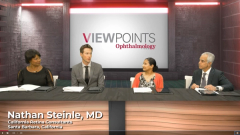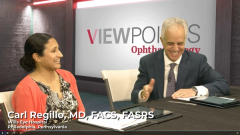
Poll: Exploring the dosing intervals of faricimab for treating neovascular AMD in the clinical practice setting
A panel of retina specialists weighed in on the dosing intervals when using of faricimab for the treatment of neovascular AMD in the clinical practice setting. Do you agree with them?
In a panel discussion, retina specialists discussed the value of extended dosing intervals. Prethy Rao, MD, MPH made note that extending time between doses can make treatment for accessible to patients from both a time commitment stand point and also from an insurance coverage standpoint.
As the discussion around dosing intervals continues, Carl Regillo, MD, FACS, FASRS, shares his insights on the drying effects of faricimab and aflibercept. He notes that he extends time between doses by 1 to 2 weeks.
How long would you extend the dosing interval for neovascular AMD patients?
Episodes in this series

Discussion transcript edited for clarity
Nathan Steinle, MD: Dr Rao, what would this mean for your clinic then if all of a sudden you could start dosing patients Q12 and Q16 weeks?
Prethy Rao, MD, MPH: Amazing. I go to a lot of faraway satellite clinics as we all do for retina specialists. Even in our satellite clinics, a lot of the patients are coming from even further so a lot of my patients even in the satellite clinics come out from 2 to 3 hours away to be able to be seen. To be able to offer a treatment where they’re only able to come in every 4 months, maybe every 5 months is groundbreaking because again transportation is an issue as well as covering care as well. We think about copays and insurances. It’s easy to pay the copay but it’s a significant monetary burden for these patients as well.
Nathan Steinle, MD: Absolutely. And in the trials they had fixed aflibercept dosing at Q8 weeks. How do you use aflibercept in your clinics and have you noticed a difference between faricimab and aflibercept?
Prethy Rao, MD, MPH: I think for aflibercept I’ve been able to extend beyond 8 weeks. I think what is typically normal is about the 10-week mark I’d say. I do feel like in some of my patients I’m able to get them out to the 12-week dosing but then at some point, there’s more of a tachyphylaxis effect, and they end up dropping down to about 10 weeks. I’d say probably the 10- to 11-week mark is pretty typical for me.
Nathan Steinle, MD: Dr Regillo, I’ll go back to you for the phase 3 trial. So for at least the first part when they’re in match-dosing phase. Talk to me about the drying effect of faricimab vs aflibercept.
Carl Regillo, MD, FACS, FASRS: That could tie into the added mechanism of action that we’ve been talking about here. It tends to dry a little bit better and a little faster and that could have an advantage for some of our patients. On average we don’t see added visual acuity gains but nonetheless patients like the notion of at least getting the same vision outcomes with less treatment. In fact, in study 2, the second year, which utilized that personalized treatment interval which it is very much akin to what we do in practice in extending or bringing back the intervals; it was also by 4-week intervals. It’s become customary that we do the treatment extend or change the treatment interval by 2-week intervals. So, to push that by 4 weeks is another aspect of the study design that guides us in practice or potentially guides us in practice in terms of what we might be able to get away with like accelerated extensions in addition to extensions beyond our customary 3 months.
I tested aflibercept prospectively to see if that drug can last to 18 weeks in a small IST [inappropriate sinus tachycardia]. A small percentage could get out there. About 38% could get to 12 weeks comfortably to keep the macula dry and some were able to go 14 weeks or even 16 weeks but it was a smaller percentage. Now keep in mind, these study designs may be slightly different from what they allow in the study for disease activity or some recurrent disease activity to adjust the dosing interval. We should mention that because in practice the drugs may not last quite as long as they seem to do in clinical trials.
Nathan Steinle, MD: That’s a really good point. I think I’m becoming more bold too with my extension periods. How far have you extended the time? Do you do 1, 2, 3, or 4 weeks? What do you typically do?
Prethy Rao, MD, MPH: I think I probably wouldn’t go beyond 2 weeks at this point. I think maybe over time with these durable agents I’m able to be a little bit more bold in doing 3 or 4 weeks, but I think for now I do 2 weeks.
Nathan Steinle, MD: How about you Dr Scott?
Adrienne Scott, MD: I agree with them. I’m 1 to 2 weeks. I figure that logistically makes sense for the office, the patient, and my schedule.
Transcript edited for clarity
Newsletter
Keep your retina practice on the forefront—subscribe for expert analysis and emerging trends in retinal disease management.

















































